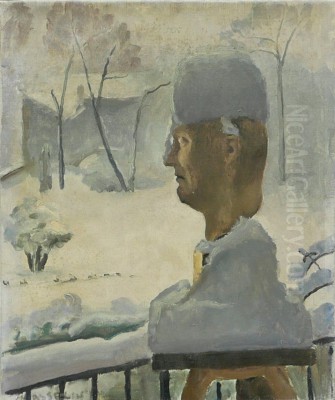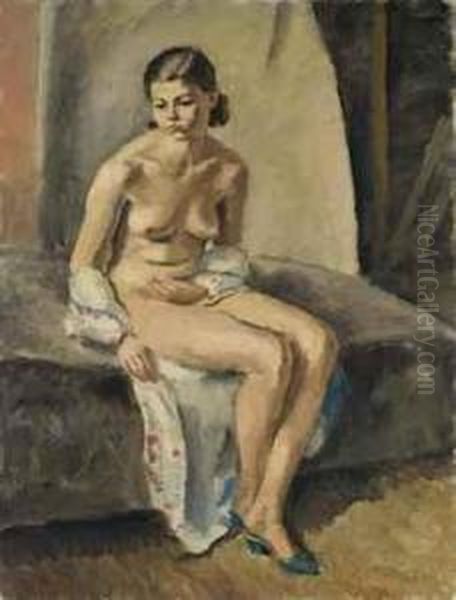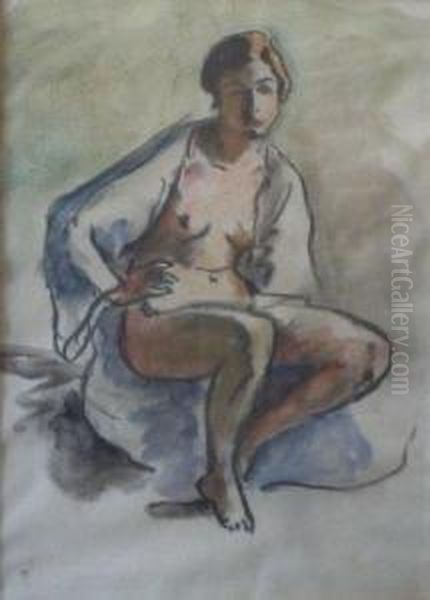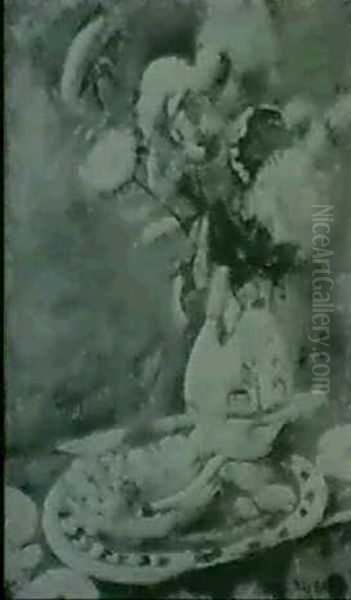
Maurice Asselin stands as a significant figure in early 20th-century French art. Born in Orléans in 1882 and passing away in 1947, he dedicated his life to painting and printmaking. As an active member of the vibrant School of Paris, Asselin carved a niche for himself with a style rooted in realism yet sensitive to the nuances of light and emotion, often standing apart from the more radical avant-garde movements of his time. His work offers a window into the artistic currents flowing through Paris and France during a period of profound social and cultural change.
Early Life and Artistic Formation
Asselin's journey began in the historic city of Orléans. While details of his earliest training are not extensively documented in the provided materials, his artistic trajectory clearly shows an engagement with the foundational principles of French painting. He eventually made his way to Paris, the undisputed center of the art world at the time. There, he absorbed the influences of past masters and contemporary trends.
His artistic development was notably shaped by the legacy of 19th-century realism. The influence of painters like Gustave Courbet, known for his unvarnished depictions of everyday life and his rejection of academic idealism, can be discerned in Asselin's commitment to portraying the world around him with honesty. However, Asselin was not merely an imitator; he synthesized these influences into a personal vision.
Life Between Paris and Brittany
Asselin's life and work were geographically divided between the bustling metropolis of Paris and the rugged, picturesque region of Brittany. In Paris, he was immersed in the city's dynamic art scene, associating with fellow artists and participating in exhibitions. He shared living spaces and artistic dialogues with contemporaries such as Jacques Gaston Emile Vaillant and Emile Jourdan, fostering a community of creative exchange.

Brittany, particularly the southern Finistère coast, offered a contrasting environment that deeply inspired him. He frequented areas like Brigneau, Ponant, Riec, and the well-known artists' hub of Concarneau. This region, famed for its dramatic landscapes, maritime life, and distinct cultural identity, provided rich subject matter. Asselin, along with artists like Vaillant, often traveled between the urban intensity of Paris and the coastal tranquility of Brittany, allowing both environments to shape his artistic output.
The "Réaction Réaliste" and Artistic Style
Maurice Asselin is closely associated with a movement or tendency known as the "Réaction Réaliste" (Realist Reaction). This group of artists sought a return to more representational forms and a focus on observable reality, partly in response to the abstractions of Cubism and the intense subjectivism of Expressionism. Within this context, Asselin stood alongside prominent figures like André Dunoyer de Segonzac, Charles Dufresne, Paul-Émile Gernez, and Henry de Waroquier.
These artists, while diverse in their individual styles, shared a connection to the lineage of 19th-century French painting, balancing traditional techniques with modern sensibilities. They represented a form of modern realism that valued craftsmanship and direct observation. Art historian Bernard Dorival characterized Asselin's position within this group as leaning towards the "frank realism" found in Impressionism, highlighting his sincere exploration of nature and life.
Asselin's style is often described as soft and delicate. He possessed a refined sense of color, frequently employing harmonious and warm palettes. His brushwork, while grounded in realistic representation, conveyed sensitivity and nuance. He was not interested in mere photographic reproduction; instead, he sought to capture the essence and atmosphere of his subjects, whether landscapes, portraits, or still lifes. His work embodies a love for life and a desire to communicate it through the medium of paint.
While appreciating the directness of Impressionism, Asselin also seemed to question the limits of purely objective representation of nature. His art suggests a deeper engagement with the subject, imbuing scenes with a quiet emotional resonance. He navigated a path between academic tradition and modernist experimentation, creating a body of work that feels both timeless and distinctly of its era.
Themes and Subjects
Asselin's oeuvre encompasses a diverse range of subjects, reflecting his broad interests and keen observational skills. He was adept at landscape painting, capturing the specific light and atmosphere of both urban Paris and coastal Brittany. His travels provided him with a wealth of inspiration, from cityscapes to seascapes and rural scenes.

A poignant aspect of his work involves depictions of war and its aftermath. His painting of the ruins of Saint Paul's Church in his native Orléans stands as a powerful example. This work transcends simple documentation, conveying the tragedy and desolation of conflict through sensitive handling of light and color. It reflects a deep contemplation of destruction and perhaps a longing for peace.
Portraiture was another significant genre for Asselin. He captured the likenesses of individuals with psychological insight, suggesting their personality and inner life. His approach to the human figure extended to nudes, a subject he treated with sensitivity, focusing on form and light rather than overt eroticism, although this sometimes led to controversy.
Still life provided a further avenue for exploring form, color, and texture. Asselin arranged everyday objects, flowers, and masks into compositions that highlight the beauty in the ordinary. These works often showcase his subtle color harmonies and delicate brushwork. Additionally, he occasionally produced humorous illustrations, demonstrating a lighter side to his artistic personality.
Notable Works and Exhibitions
Several works stand out as representative of Maurice Asselin's artistic contributions. His painting L'église Saint Paul, Orléans (The Church of Saint Paul, Orléans) is particularly noteworthy. It depicts the church ruins following bombing during World War II (specifically mentioned as the 1940 bombing in the source material, though care must be taken with exact timelines relative to Asselin's life). The work is praised for its soft tones and sensitive rendering of the devastated structure, capturing a mood of solemn reflection.
In the realm of figure painting and still life, works from the 1930s like A woman in white bathrobe, Still-life with a mask, and Nasturtiums in a vase exemplify his mature style during that decade. These paintings likely showcase his characteristic blend of realism, gentle color palettes, and atmospheric sensitivity. Another mentioned work, The Lords, further indicates his engagement with figure-based compositions.
Asselin was an active participant in the Parisian art world. He designed the entrance ticket for the prestigious Salon d'Automne in 1936, a mark of recognition from his peers. He also contributed prints for the Paris World's Fair in 1937, demonstrating his involvement in significant cultural events.

His work Femme nue assise (Seated Nude Woman) became the subject of controversy in 1935 when it was censored and prohibited from being displayed at the 22nd National Art Exhibition (likely the Nikakai exhibition or a similar major show) in Japan. This incident highlights the differing cultural sensitivities regarding the depiction of the nude at the time and underscores Asselin's engagement with this traditional yet often contested subject.
Another work mentioned is a color print titled Nu assi (Seated Nude), noted as being held in a specific library collection. This indicates his activity in printmaking alongside painting. It is crucial to distinguish Asselin's work from similarly titled pieces by other artists, such as Pablo Picasso.
Asselin was also identified as a member (Kai-in) of "Nikak," described as a structure association. Given the context of the Japanese exhibition censorship, "Nikak" likely refers to the influential Japanese art association Nikakai, suggesting Asselin had connections or exhibited with this group, fostering international artistic exchange.
Artistic Circles and Connections
Beyond the artists directly associated with the "Réaction Réaliste," Asselin moved within wider artistic and literary circles. His time spent in Brittany, particularly around Pont-Aven – a location famous from the time of Paul Gauguin and Paul Sérusier – placed him in a region rich with artistic history and activity.
He had connections with the writer Pierre Mac Orlan. While the provided text doesn't confirm specific collaborations, such as Asselin illustrating Mac Orlan's books, it notes their presence in the same locales (like Pont-Aven and Saint-Cyr-sur-Morin) known as gathering places for artists and writers. Mac Orlan himself often collaborated with artists for illustrations, making interaction between him and Asselin plausible. Their association points to the fertile cross-pollination between literature and the visual arts during this period.
Asselin's position within the School of Paris meant he was contemporary to many other major figures, even if direct collaboration isn't documented. Artists like André Derain, Othon Friesz, and Albert Marquet were exploring related paths in post-Impressionism and Fauvism, contributing to the diverse tapestry of early 20th-century French art. Asselin also maintained friendships and artistic dialogues with figures like the British painter Walter Sickert, who shared an interest in modern realism and scenes of everyday life.
Printmaking and Illustration
Maurice Asselin was not only a painter but also a skilled printmaker. The source material specifically mentions his work in drypoint, a demanding intaglio technique known for the velvety quality of its lines. A publication titled Éloge de Maurice Asselin (In Praise of Maurice Asselin) is noted as containing a significant number of his original drypoints (mentioned as 80 or 90 plates), showcasing his mastery of this medium.
Drypoint involves scratching directly onto a metal plate (usually copper) with a sharp needle. This process creates a burr alongside the incised line, which holds extra ink and produces a characteristic soft, rich line when printed. Asselin likely used this technique to explore themes similar to his paintings – portraits, nudes, landscapes – translating his sensitive style into graphic form.
He also engaged in book illustration, although specific titles beyond general references like "Birds" and "Fables" are not detailed in the provided text. Illustration offered another avenue for artists of the period to disseminate their work and engage with literary themes. Furthermore, one anecdote mentions Asselin's portrait being used as an illustration in a book concerning radio and war, indicating his public profile and relevance to contemporary issues.
Critical Reception and Legacy
Maurice Asselin was recognized during his lifetime as a significant contributor to French art. He was seen by some critics and historians as an important link in the chain of French realism, an heir to the independent masters of the late 19th century. His work was perceived as a counterpoint to the more radical directions of Cubism and Surrealism, upholding values of observation, craftsmanship, and emotional sincerity.
The assessment by art historian Bernard Dorival is particularly telling. Dorival placed Asselin firmly within the "Realist Reaction," emphasizing his affinity for the directness of Impressionism combined with a dedicated, almost questioning, exploration of nature. This view suggests Asselin was not simply repeating Impressionist formulas but was engaged in a thoughtful dialogue with its legacy, seeking a realism imbued with personal feeling and atmospheric depth.
His commitment to depicting life with sensitivity and his mastery of traditional techniques combined with a modern sensibility secured his reputation. While perhaps not as revolutionary as some of his avant-garde contemporaries, Asselin's consistent vision and high-quality output earned him respect. His art offers a perspective that values intimacy, quiet observation, and the enduring beauty found in everyday scenes and human subjects.
Collections and Enduring Presence
Maurice Asselin's artistic legacy endures through his works held in various collections. The Église Saint Paul in Orléans holds his poignant depiction of its own ruins, a testament to his connection with his hometown and his ability to capture historical moments with artistic grace.
While the provided text initially mentions the Musée Rolin (located in Autun, not Orléans as mistakenly suggested) potentially holding his work, it later retracts this, stating there's no confirmation. However, it is highly likely that Asselin's paintings and prints are represented in major French public collections, particularly those focusing on early 20th-century art, such as the Musée National d'Art Moderne (Centre Pompidou) in Paris or the Musée des Beaux-Arts in Orléans, given his stature and origins.
His works also continue to circulate in private collections and appear on the art market. The existence of books dedicated to his work, like the Éloge de Maurice Asselin featuring his drypoints, further solidifies his place in art history. His paintings, such as The Lords, A woman in white bathrobe, and Still-life with a mask, remain appreciated for their technical skill and sensitive portrayal of their subjects.
Conclusion
Maurice Asselin represents a vital, albeit sometimes overlooked, strand of early 20th-century French art. As a painter and printmaker of the School of Paris, he navigated the complex artistic landscape of his time by forging a personal style grounded in realism but infused with the sensitivity to light and atmosphere inherited from Impressionism. Associated with the "Réaction Réaliste," he, alongside artists like Segonzac and Dufresne, championed representational art that valued keen observation and emotional depth over radical abstraction.
From the ruins of war-torn Orléans to the tranquil coasts of Brittany, and from intimate portraits to delicate still lifes, Asselin's work consistently reflects a deep engagement with the world around him and a profound love for the act of painting. His art, characterized by harmonious color, subtle execution, and quiet sincerity, continues to resonate, offering a vision of realism that is both aesthetically pleasing and emotionally engaging. He remains an important figure for understanding the diversity and richness of French art between the decline of Impressionism and the rise of later modernist movements.